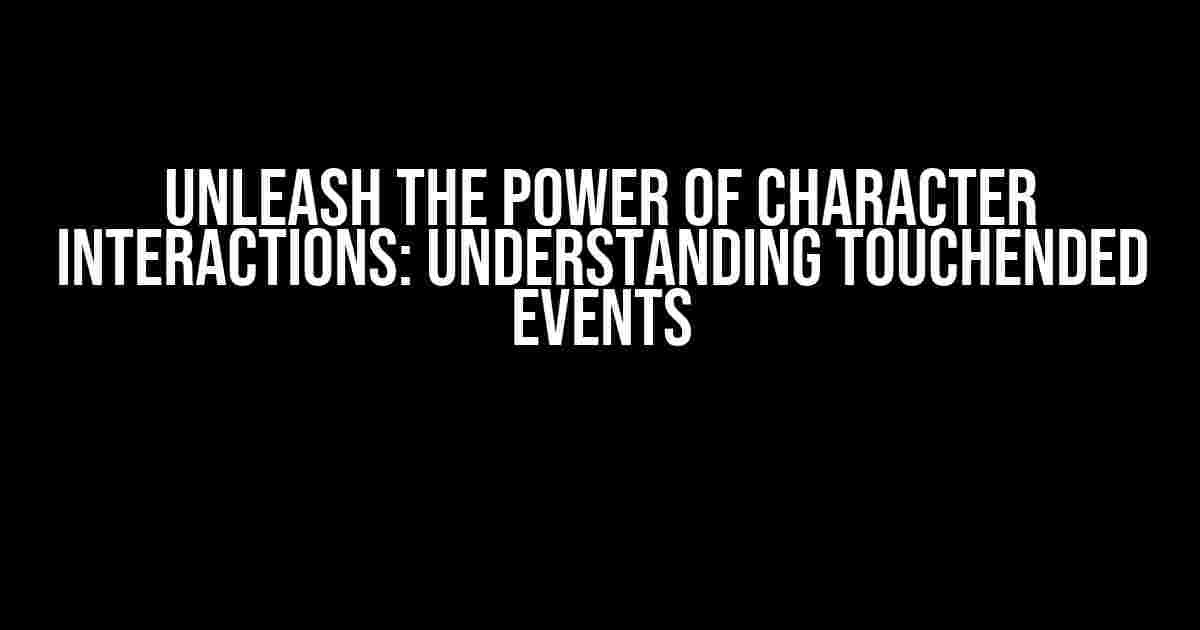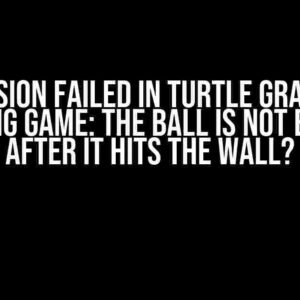Are you tired of dealing with pesky character collisions that don’t quite work as intended? Do you find yourself scratching your head, wondering why your characters aren’t responding to each other’s presence? Fear not, dear developer, for we’re about to dive into the fascinating world of character interactions and the often-misunderstood TouchEnded event!
What is the TouchEnded Event?
The TouchEnded event is a fundamental concept in character interactions, allowing your characters to respond to each other’s presence in a realistic and engaging way. But what exactly does it do?
In simple terms, the TouchEnded event is triggered when one character stops intersecting with another character. Yes, you read that right – stops intersecting! This event is the perfect opportunity to create a response, such as playing an animation, triggering a sound effect, or even initiating a complex sequence of actions.
When Does the TouchEnded Event Fire?
The TouchEnded event fires under the following circumstances:
- Character A intersects with Character B.
- Character A stops intersecting with Character B.
- The TouchEnded event is triggered on Character A.
It’s essential to note that the TouchEnded event only fires when the intersection between the two characters is broken. If Character A continues to intersect with Character B, the event will not be triggered.
How to Set Up Character Intersections
Before we dive into the TouchEnded event, let’s cover the basics of setting up character intersections. You’ll need to follow these steps:
- Create two characters, Character A and Character B, with their respective colliders.
- Ensure that the colliders are set up correctly, with the correct shape and size.
- In the Inspector, check the “Is Trigger” box on the collider component of Character A.
- Attach a script to Character A that contains the necessary logic for handling the TouchEnded event.
The Magic of Scripting
Now that we have our characters set up, let’s create a script that will handle the TouchEnded event. Create a new C# script and attach it to Character A:
using UnityEngine;
public class CharacterTouchEnded : MonoBehaviour
{
void TouchEnded(Collider other)
{
// Code to handle the TouchEnded event goes here
Debug.Log("TouchEnded event fired!");
}
}This script is simple, but it demonstrates the basic concept of handling the TouchEnded event. When Character A stops intersecting with Character B, the TouchEnded event will be triggered, logging “TouchEnded event fired!” to the console.
Real-World Applications of the TouchEnded Event
The TouchEnded event has numerous applications in game development, including:
| Application | Description |
|---|---|
| Fighting Games | Use the TouchEnded event to detect when characters stop colliding, triggering a recovery animation or resetting their combat state. |
| Platformers | Implement the TouchEnded event to detect when the player character stops touching a platform, allowing for smooth transitions between platforms. |
| Adventure Games | Utilize the TouchEnded event to detect when characters stop interacting, such as when the player stops talking to an NPC or exits a room. |
These examples illustrate the versatility of the TouchEnded event, demonstrating its potential to enhance the overall gaming experience.
Common Pitfalls and Troubleshooting
As with any complex system, the TouchEnded event can sometimes behave unexpectedly. Here are some common pitfalls to watch out for:
- Failing to set up colliders correctly: Double-check that your colliders are set up correctly, with the correct shape and size.
- Forgetting to check the “Is Trigger” box: Ensure that the “Is Trigger” box is checked on the collider component of Character A.
- Not handling the TouchEnded event correctly: Verify that your script is correctly handling the TouchEnded event, and that the logic is sound.
By being aware of these potential issues, you can troubleshoot and resolve problems more efficiently, getting your characters interacting smoothly in no time!
Conclusion
The TouchEnded event is a powerful tool in the world of character interactions, allowing your characters to respond to each other’s presence in a realistic and engaging way. By following the instructions outlined in this article, you’ll be well on your way to creating immersive and interactive experiences that will captivate your players.
Remember, the key to success lies in understanding the fundamental principles of the TouchEnded event and how it interacts with your characters. With patience, practice, and a dash of creativity, you’ll be able to unlock the full potential of this event and take your game development to the next level!
Happy coding, and may your characters interact in harmony!
Frequently Asked Questions
Got curious about how characters interact with each other in a virtual world? Find the answers to your burning questions about character fires TouchEnded event if another character intersects with the same character!
Q1: Why does my character fire TouchEnded event when another character collides with it?
When two characters intersect, it triggers the TouchBegan event. However, when the colliding character moves away, the TouchEnded event is fired to signal the end of the intersection. This behavior helps maintain a consistent interaction flow between characters in your virtual world!
Q2: Can I prevent my character from firing TouchEnded event when another character intersects?
Yes, you can! By setting the `Is Trigger` property to `false` on your character’s collider, you can prevent the TouchEnded event from firing. This way, you have full control over when and how your character responds to interactions.
Q3: What happens if multiple characters intersect with my character at the same time?
When multiple characters intersect with your character, it’s considered a single intersection event. The TouchBegan event will fire once, and the TouchEnded event will fire when all characters have moved away. This ensures that your character responds consistently, even in complex intersection scenarios!
Q4: Can I detect which character intersected with my character?
Absolutely! By accessing the `other` property in the TouchBegan or TouchEnded event handler, you can identify which character intersected with your character. This information allows you to create targeted responses and interactions tailored to specific characters.
Q5: Are there any performance concerns when dealing with multiple character intersections?
While handling multiple character intersections can be computationally intensive, Unity’s physics engine is optimized to handle such scenarios efficiently. However, it’s essential to ensure your character’s collider is properly configured and optimized for best performance.


